Car photography has become increasingly popular in recent years, with more and more enthusiasts and professionals alike capturing stunning images of automobiles.
Consequently, the demand for high-quality cameras suitable for car photography is at an all-time high.
To help you navigate the ever-expanding market, we have compiled a list of the best cameras for car photography in 2024.
Whether you are a beginner looking to explore this genre or a seasoned photographer aiming to upgrade your gear, this article will provide you with valuable insights and recommendations.
We have carefully evaluated various cameras based on their image quality, performance, versatility, and features specifically tailored for car photography.
From mirrorless cameras to DSLRs, we have covered a wide range of options to suit different preferences and budgets.
So, let’s delve into the world of car photography and discover the cameras that will help you capture automotive beauty in its finest form.
Best Budget-Friendly Cameras for Car Photography
Here’s a list of some of my favorite (hand-picked by pro photographer) cameras for car photography…
- Canon EOS Rebel T7
- Nikon D3500
- Sony Alpha a6000
- Panasonic Lumix G7KS
- Canon EOS 5D Mark IV
- Sony a7R V
- Nikon D850
- Fujifilm GFX 100S
- Fujifilm X-T200
- Nikon D750
now let’s understand each camera in detail to improve car photography…
Canon EOS Rebel T7

If you are looking for the best budget-friendly camera for car photography, the Canon EOS Rebel might be the one you are looking for!
The Rebel T7 camera boasts a 24.1 Megapixel CMOS (APS-C) sensor and a broad ISO range of 100-6400 (which can be expanded to 12800), making it highly capable of producing clear car photos even in low light conditions.
Additionally, the camera’s DIGIC 4+ image processor allows for quick and precise image processing, resulting in vivid and sharp car shots.
Pros of the Canon EOS Rebel T7
- Features an optical viewfinder that offers approximately 95% viewing coverage.
- beginner-friendly interface and intuitive controls.
- Has various shooting modes including Auto, Scene Intelligent Auto, and Creative Auto.
- Has built-in Wi-Fi and NFC technology.
- Supports SD, SDHC, and SDXC Memory Cards.
- Can record Full HD 1080p videos.
Cons of the Canon EOS Rebel T7
- Lacks an articulating screen, which can limit flexibility when shooting from various angles.
- The autofocus system may not perform well in fast-paced car photography.
- The camera has limited speed in burst mode.
- Battery life is approximately 600 shots according to CIPA standards.
Nikon D3500
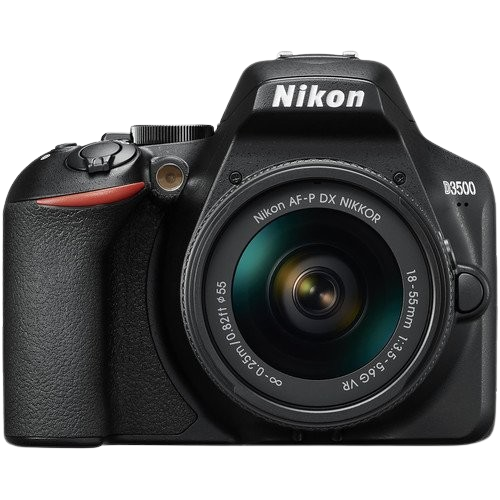
Known for its high-quality entry-level DSLRs, Nikon produces a variety of high-quality camera models for beginner car photographers.
Among their D3XXX-series, the Nikon D3500 stands out for its excellent image quality and affordability.
Thanks to its 24.2-megapixel APS-C CMOS sensor, this camera can capture car photographs with excellent sharpness and color accuracy.
It also offers excellent performance and low noise at high ISO settings, making it an excellent choice for capturing cars in varying lighting conditions.
Pros of the Nikon D3500
- Excellent image quality that beats some pricey competitors.
- In terms of ease of use, it is comparable to a point-and-shoot camera.
- Comfortable grip for extended use.
- Has an impressive battery life of approximately 1,550 shots per charge.
- Features an easy-to-use Guide Mode, which provides step-by-step assistance.
- Supports wireless photo transfers and sharing via Bluetooth.
Cons of the Nikon D3500:
- Does not have a touch screen.
- Struggles with continuous autofocus tracking.
- No mic input is available.
- Don’t have a headphone jack.
- Lacks Wifi support.
Sony Alpha a6000
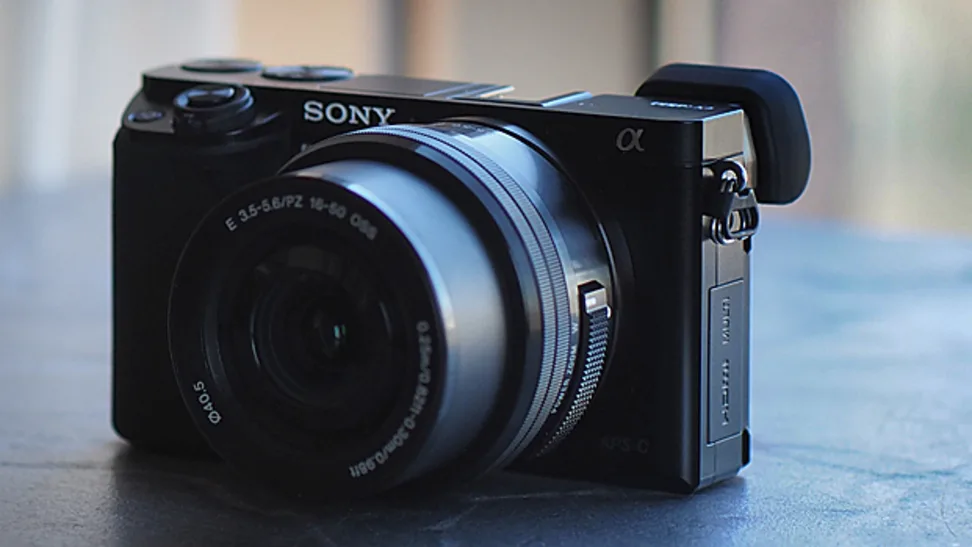
An affordable mirrorless camera from Sony, the Alpha a6000 provides excellent image quality and advanced features.
It features a 24.3-megapixel APS-C sensor, which delivers sharp and detailed images with vibrant colors.
The a6000 also boasts a fast hybrid autofocus system with 179 phase-detection points, allowing for quick and accurate subject tracking.
With its burst shooting capability of 11 frames per second, it’s ideal for capturing fast-moving cars.
The camera is also equipped with WiFi and NFC connectivity, so you can share photos and control it remotely from your smartphone.
Pros of the Sony Alpha a6000
- Compact and lightweight design.
- High-resolution sensor for detailed images.
- Fast and accurate autofocus system.
- Advanced shooting modes and customizable settings.
- Built-in Wi-Fi and NFC connectivity.
Cons of the Sony Alpha a6000
- Limited battery life compared to DSLR cameras.
- No touchscreen functionality.
- Limited selection of native lenses compared to other brands.
Panasonic Lumix G7KS
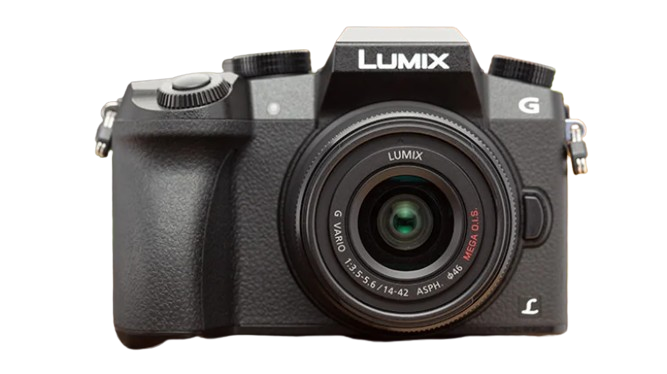
Need a budget-friendly mirrorless camera for car photography? Panasonic Lumix G7KS might be the right camera for you.
For beginners who are looking for a good camera for car photography without breaking the bank, this camera offers decent specs, a lightweight body, and an affordable price.
It features a 16-megapixel camera that is capable of taking photos with good detail and sharpness.
Beginners can easily customize things like aperture and speed with its intuitive controls, making it an ideal option for those who are just starting out in car photography.
Definitely, it doesn’t have professional specs like many of the cameras mentioned in this article, but you can start with it and upgrade when you’re ready for the next level.
Pros of the Panasonic Lumix G7KS
- Wide ISO range (Up to 25600).
- Can take great-quality images.
- Accurate color reproduction.
- Can shoot in 4K.
- Has image stabilization.
- Features an intelligent image processor.
- 2350k-dot OLED Live viewfinder.
- High-speed AF with DFD technology.
Cons of the Panasonic Lumix G7KS
- Average battery life.
- The handgrip is small.
- Not available as a body only.
- Average build quality.
- 4K photo processing speed is a bit slow.
Best Feature Rich cameras for Car photography
Canon EOS 5D Mark IV
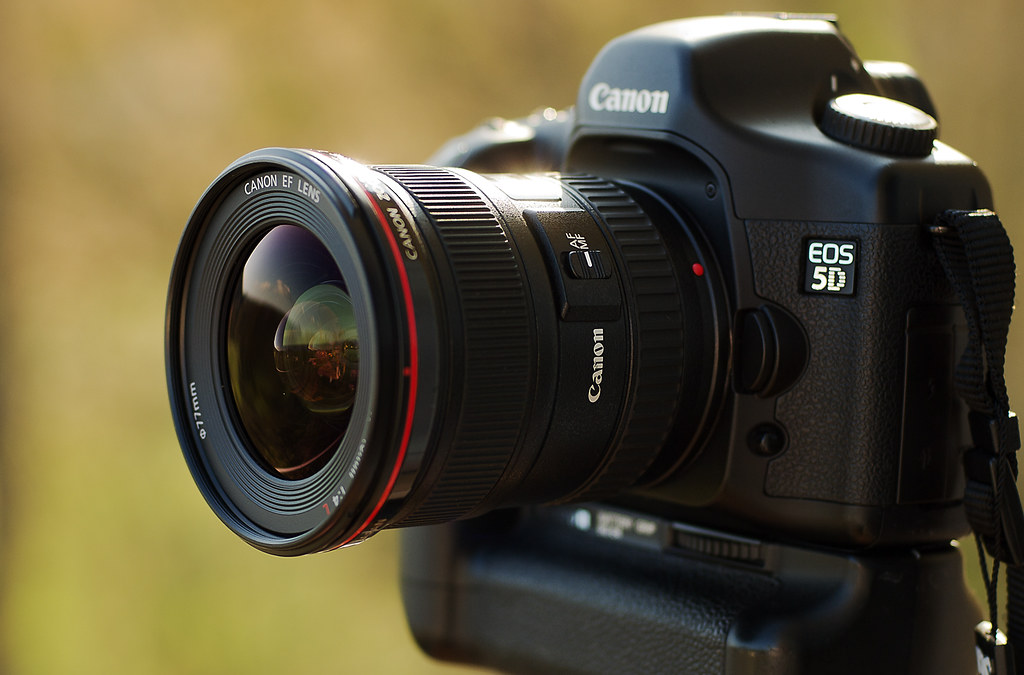
Loved by professional and experienced car photographers alike, the Canon EOS 5D Mark IV is a powerhouse camera that offers exceptional image quality and versatility.
With its 30.4-megapixel full-frame sensor, you can take high-resolution car photographs with excellent dynamic range.
Even when photographing fast-moving cars in challenging lighting conditions, the camera’s advanced autofocus system with 61 focus points ensures accurate and fast focusing.
The 5D Mark IV also boasts a wide ISO range of 100-32000, expandable up to 102400, allowing for great low-light performance.
This DSLR camera also includes reliable GPS and Wi-Fi connectivity, so you can tag locations and transfer images wirelessly.
Pros of the Canon EOS 5D Mark IV
- Performs well in any situation.
- Highly customizable and intuitive control menu.
- Excellent image quality with high resolution and dynamic range.
- Outstanding color accuracy.
- Decent battery life.
- Advanced autofocus system.
- Wide ISO range for great low-light performance.
- Built-in GPS and Wi-Fi for convenient location tagging and wireless transfer.
- Two automatic white balance modes.
- Weatherproofed body.
Cons of the Canon EOS 5D Mark IV
- Battery drains quickly when GPS is enabled.
- Relatively heavy and bulky compared to some mirrorless options.
- Limited 4K video capabilities.
Sony a7R V
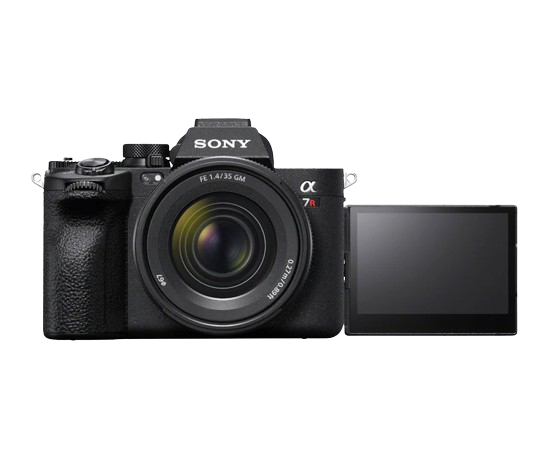
Sony has long been the preferred choice of car photography enthusiasts because of their excellent image quality, unmatched autofocus capabilities, and remarkable low-light performance.
With its impressive lineup, the Sony a7R V lives up to the reputation it has garnered from its predecessors.
The A7R V sets itself apart with its superior image processing capabilities, giving car photographers a distinct advantage.
Featuring a 61MP image sensor and AI-powered autofocus, this remarkable mirrorless camera is able to handle high-speed motorsports shots with remarkable agility.
Pros of the Sony a7R V
- Outstanding 61 MP full-frame sensor.
- Powerful image processing engine
- 693-point AF with exceptional subject detection.
- Supports 4K and 8K.
- 8-stop Image stabilization.
- 7fps Raw capture.
- Sharp electronic viewfinder.
- Dual-tilting touch screen.
- Wide ISO range that is expandable to 102,400.
- Customizable controls.
- Dual memory card slots.
- AI-powered smart tracking focus.
- high-end SD or CFExpress is needed.
Cons of the Sony a7R V
- Vague subject recognition menu.
- Pixel-shift shooting requires using desktop software.
- Relatively Compact battery.
- No 240fps refresh option.
- Expensive.
Nikon D850
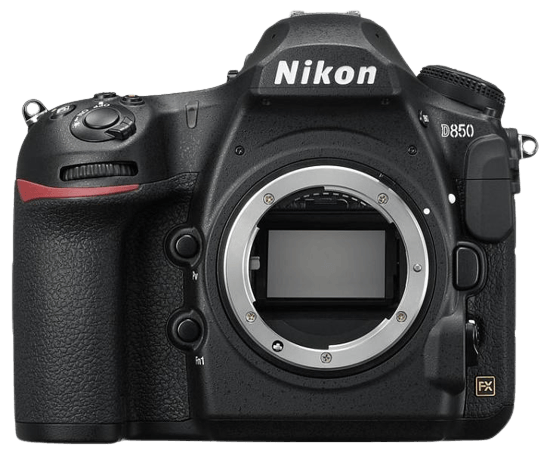
Nikon’s D850 is a sought-after DSLR camera for car photography due to its impressive features.
Featuring a 45.7-megapixel FX-format CMOS image sensor with back-side illumination (BSI), it provides incredible resolution without an optical low-pass filter.
Known for its fast operation and precise autofocusing, as well as excellent low-light performance, it can take sharp, well-focused photographs even in dimly lit environments.
A multitude of features make the D850 an incredibly versatile camera, offering a variety of settings to cater to any car photographer’s needs.
Pros of the Nikon D850
- Impressive image quality with exceptional resolution and dynamic range.
- Advanced autofocus system for precise subject tracking.
- Wide ISO range for excellent low-light performance.
- Durable build quality suited for rugged shooting environments.
- Fast autofocus system for accurate shooting.
- Full manual controls for more creative shooting.
Cons of the Nikon D850
- Higher price point than some competitors.
- The optical viewfinder doesn’t offer full coverage.
- Large file sizes.
Fujifilm GFX 100S
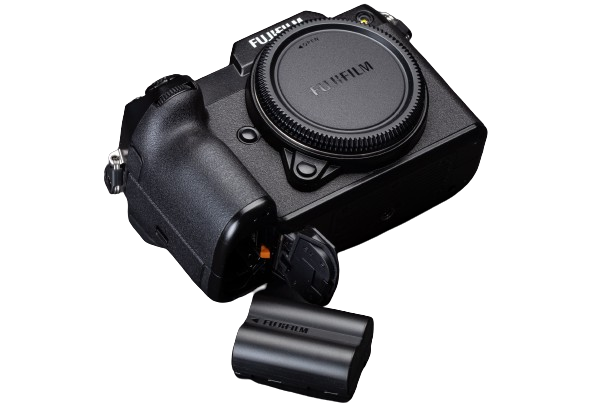
The sharpest details with beautiful color reproduction and advanced autofocus are what the Fujifilm GFX 100S is all about.
With its 102 Megapixel incredible back illuminated CMOS sensor, combined with its 4-quad core CPU, it’s the king of high-resolution cameras enabling you to take stunningly detailed and vibrant car photos.
Aside from its impressive sensor, the camera offers 6 stops in vibration reduction with its 5-axis stabilization.
Pros of the Fujifilm GFX 100S
- 102 MP large format CMOS sensor.
- 2.36 million dot tilt LCD display.
- Advanced phase detection autofocus.
- Supports SD and HDMI output.
- Up to 6 stops of 5-axis image stabilization.
- Supports 4K video capture.
- Compact body.
Cons of the Fujifilm GFX 100S
- Expensive.
- The electronic viewfinder needs some improvement.
- 5fps continuous shooting speed.
- Average battery life.
Other notable cameras for car photography
Fujifilm X-T200

An excellent mirrorless camera with a range of creative features, the Fujifilm X-T200 offers excellent image quality.
This camera features a 24-megapixel APS-C sensor and produces detailed images with rich colors and impressive dynamic range.
The X-T200 also features a fast autofocus system with 425 phase-detection points, ensuring sharp focus on moving subjects.
It offers a variety of film simulation modes, allowing you to create unique and artistic looks for your car photographs.
Moreover, with its vari-angle touchscreen LCD, you can capture high-angle and low-angle shots with ease.
Pros of the Fujifilm X-T200
- Stylish and ergonomic design.
- Excellent image quality with film simulation modes.
- Fast and accurate autofocus system.
- Vari-angle touch screen LCD for flexible shooting angles.
- 4K video recording capabilities.
Cons of the Fujifilm X-T200
- Comparatively fewer lens options.
- Limited battery life for extended shooting sessions.
- Lower burst shooting speed compared to some other models.
- No built-in image stabilization.
Nikon D750

A midsize DSLR with a full-frame sensor, the Nikon D750 delivers exceptional image quality and powerful specs, considering its price is well below many professional car photography cameras.
Aside from its 24.3 MP camera resolution, this camera also has an extensive range of ISO that can go up to 51200, making it an excellent choice for car photography in various situations.
With its ability to capture at 65 fps, you don’t have to worry about capturing fast-moving cars with precision.
Furthermore, it also supports Wi-Fi for easy photo sharing and transfer.
Pros of the Nikon D750
- Excellent image quality.
- Great ISO performance.
- Excellent battery life.
- Ultra fast Autofocus.
- 24.3MP full-frame sensor.
- Supports Wi-fi.
- Tilt display.
- Dual card slots.
Cons of the Nikon D750:
- AF in live view mode is a little bit slow.
- Limited max continuous shooting rate.
- The autofocus button is missing.
Things to Consider While Choosing the Best Cameras for Car Photography
Capturing stunning car photos requires meticulous attention to detail and the right equipment.
With a wide range of options available on the market, it is necessary to consider several important factors to choose the right one for your car photography needs.
Here are a few things you might want to consider before making a purchase:
Sensor Size
The sensor size plays a significant role in determining the image quality and low-light performance of a camera.
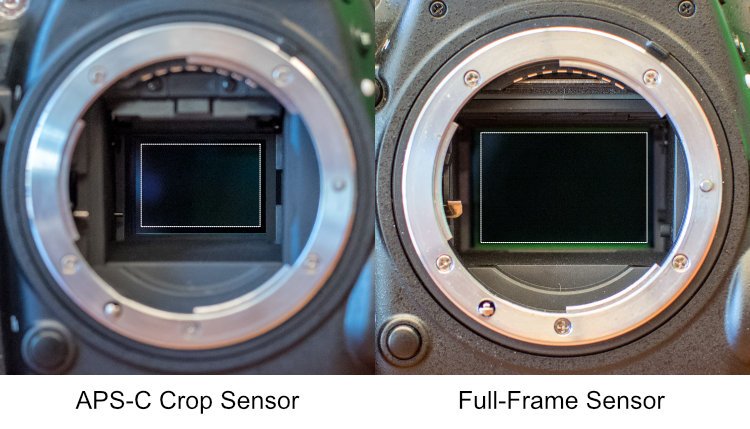
Larger sensors tend to capture more light, resulting in enhanced image quality, dynamic range, and reduced noise.
When choosing a camera for car photography, opt for models with larger sensor sizes, such as full-frame or APS-C sensors, to ensure detailed and vibrant images.
Resolution
The resolution of a camera determines the level of detail in your car photographs. Higher-resolution cameras produce sharper images with more pixels, allowing for greater flexibility in cropping and post-processing.
However, keep in mind that higher-resolution cameras may require larger storage capacity and more processing power.
Consider your specific needs and the amount of detail required for your car photography before deciding on the camera’s resolution.
Autofocus System
Fast and accurate autofocus is crucial when capturing moving subjects, such as cars.
Look for cameras with advanced autofocus systems that offer a wide coverage area and multiple focus points.
Additionally, consider cameras with advanced tracking capabilities to ensure a sharp focus on fast-moving cars.
A reliable autofocus system will help you capture crisp and well-focused car images, even in challenging shooting conditions.
Shutter Speed
Car photography often involves capturing moving vehicles, which requires a fast shutter speed to freeze the action.
Look for cameras that offer a wide range of shutter speeds, allowing you to adjust according to the speed of the car. Higher shutter speeds help eliminate motion blur and capture sharp images of fast-moving cars, while slower shutter speeds can be used creatively to convey a sense of motion.
Durability and Weather Resistance:
Car photography often takes place outdoors, making it essential to choose a camera that can withstand various weather conditions.
Opt for cameras with robust build quality, dust and moisture resistance, and weather sealing to ensure longevity and reliability.
This will enable you to capture stunning car images without worrying about damage caused by environmental factors.
Lens Compatibility
Consider the range of lenses available for the camera you choose. Car photography often requires a variety of focal lengths, from wide-angle for capturing the entire car to telephoto for close-up details.
Ensure that the camera you select has a wide selection of lenses available, allowing you to adapt to different shooting situations and achieve the desired composition and perspective.
FAQ(s) before picking a camera for Car photography
What is the best type of camera for me, DSLR or Mirrorless?
When deciding between a DSLR and a mirrorless camera, there are several factors to consider.
DSLRs have been popular among professional car photographers for their optical viewfinders, extensive lens options, and reliable autofocus systems which can give an advantage when taking car photographs in various situations and lighting conditions.
They also last longer battery life and better handling for those who prefer a traditional camera experience.
Mirrorless cameras, on the other hand, are preferred for their compact size, lighter weight, and quiet shooting capabilities.
They have electronic viewfinders that provide a real-time preview of the image, making it easier to compose shots and adjust settings.
Additionally, mirrorless cameras are renowned for their impressive video capabilities, so for car photographers who also want to capture car videos, mirrorless cameras are the right choice for them.
Ultimately, the choice between DSLR and mirrorless depends on individual preferences, shooting style, and intended use.
Both camera types have their pros and cons, so it’s important to consider your needs and budget before making the decision.
For high-quality car photos, does having the best camera suffice?
No matter the cost or capabilities of a digital camera, it inherently faces limitations when it comes to dynamic range, color reproduction, and capturing subtle nuances of light and color.
Despite advancements in sensor technology and image processing algorithms, digital cameras still struggle to match the dynamic range capabilities of the human eye and accurately reproduce the full spectrum of colors found in the real world.
This can result in the loss of details in highlights and shadows, as well as inaccuracies in color reproduction, especially in challenging lighting conditions or scenes with high contrast.
To overcome these limitations and enhance the final result, photographers often turn to post-production services like commercial photo editing. These services can help correct flaws and enhance photos, making the cars truly stand out in the images.
Final Thoughts
When it comes to car photography, selecting the right camera is essential. To assist you in making the right decision for you, we have put together a list of the best cameras for car photography.
We have included the advantages, disadvantages, and other important factors so that you can make an educated decision.
It is important to prioritize features such as image quality, low-light performance, and versatility to capture amazing car photos in various settings.
Additionally, you should consider the drawbacks of each camera, such as the high cost or limited lens options, before making your purchase. With the right camera, you will be able to take amazing car photos in the year ahead.
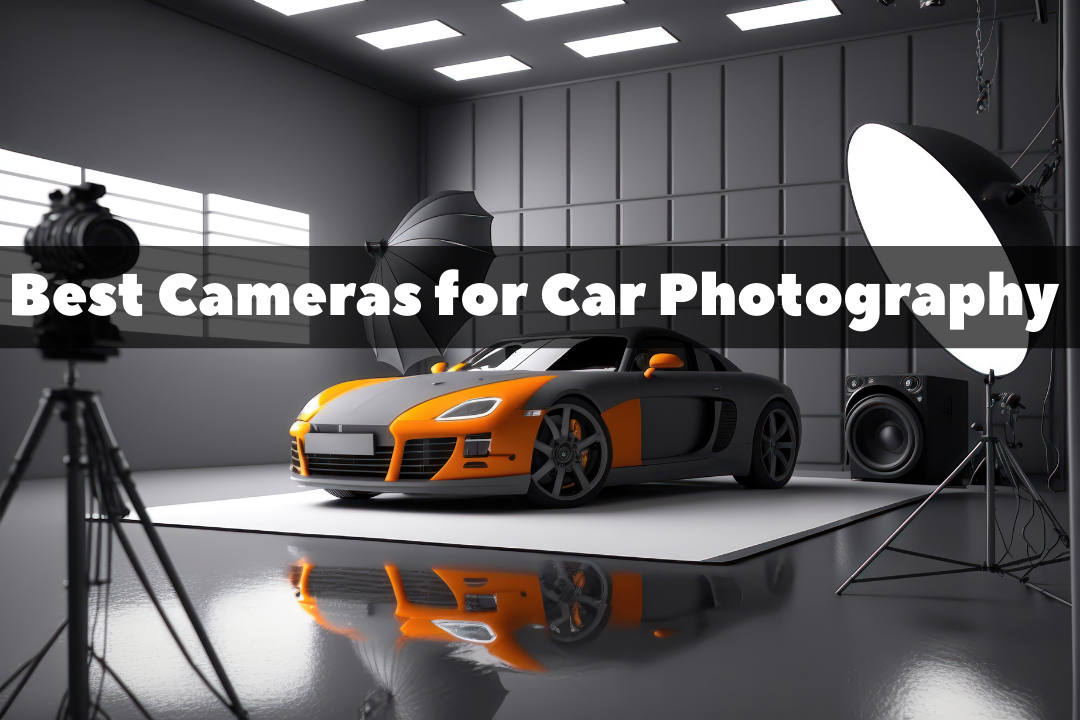
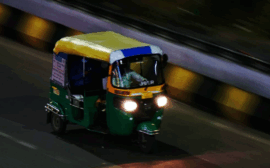


 FREE Guide Revealed!
FREE Guide Revealed! Don't Miss Out The Opportunity To Earn as Photographer in this year :)
Don't Miss Out The Opportunity To Earn as Photographer in this year :)